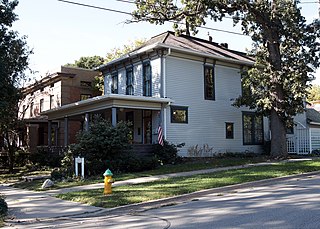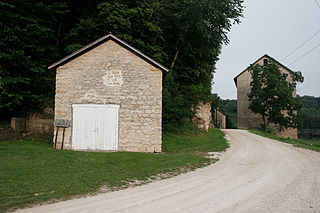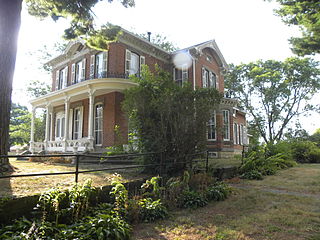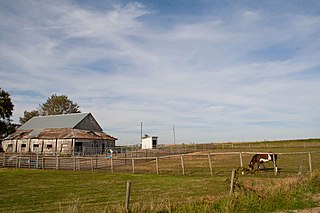
Rappahannock County is a county located in the northern Piedmont region of the Commonwealth of Virginia, US, adjacent to Shenandoah National Park. As of the 2020 Census, the population was 7,348. Its county seat is Washington. The name "Rappahannock" comes from the Algonquian word lappihanne, meaning "river of quick, rising water" or "where the tide ebbs and flows." The county is included in the Washington-Arlington-Alexandria, DC-VA-MD-WV Metropolitan Statistical Area.
Eloise Psychiatric Hospital was a large complex located in Westland, Michigan. It was named after Eloise Dickerson Davock, the daughter of Detroit's postmaster.

Mark A. Kuhn is an American grain farmer and politician. He was the Iowa State Representative for the 14th District and served in the Iowa House of Representatives from 1999 through 2011.

The Farm House, also known as the Knapp–Wilson House, is the oldest building on the campus of Iowa State University in Ames, Iowa. Now a museum open to the general public, this house was built 1861-65 as part of the model farm that eventually became Iowa State. It was designated a National Historic Landmark in 1964 for its association with agriculturist and teacher Seaman A. Knapp and with U.S. Secretary of Agriculture James Wilson, both of whom lived here while teaching at Iowa State.

The Minnesota Home School for Girls was a reformatory in Sauk Centre, Minnesota, United States. It was Minnesota's first single-sex reformatory for girls from its establishment in 1911 to 1967, when it switched to a coeducational model and shortened its name to the Minnesota Home School. The facility closed in 1999. The campus was designed on the Cottage Plan, with dispersed buildings in a bucolic setting, by Minnesota state architect Clarence H. Johnston Sr. The site has been converted to a veteran care center called Eagle's Healing Nest.
The Roswell and Elizabeth Garst Farmstead Historic District is a farm in Guthrie County, Iowa, United States, near the city of Coon Rapids. It is significant as the home of farmer and hybrid corn populizer Roswell Garst. During the 1930s and 1940s, Garst played an active role in the conversion of old-style family farms to modern agribusiness. He was a key marketer of hybrid seed corn, which greatly increased corn yields per acre. Further, he espoused the use of nitrogen and other chemical fertilizers to renew soil so that fields need not be left fallow in order for the soil to replenish, allowing farmers to grow more acres of corn. Additionally, he embraced the use of cellulose from corncobs left after processing seed corn as cattle feed.

The Iowa Soldiers' Orphans' Home, also known at the Annie Wittenmyer Home or the Annie Wittenmyer Center, located in Davenport, Iowa, United States is a former orphanage for children. It is listed on the Davenport Register of Historic Properties and as a historic district on the National Register of Historic Places. The home was originally used for orphans from the American Civil War. Starting in 1876, children from broken homes, as well as orphans from all of Iowa's 99 counties, were taken in at the home.

The Linn County Courthouse is located on May's Island in the middle of the Cedar River in Cedar Rapids, Iowa, United States. It, along with the Veterans Memorial Building and two other buildings, is a contributing property to the May's Island Historic District that was listed on the National Register of Historic Places in 1978. The courthouse is the third building the county has used for court functions and county administration.

Henderson Hall Historic District is a National Register of Historic Places (NRHP)-listed historic district in Boaz, Wood County, West Virginia. The primary contributing property is Henderson Hall, a home in the Italianate style from the first half of the 19th century. Other residences at the site are a tenant house from the end of the 19th century, and "Woodhaven", the 1877 home of Henry Clay Henderson. Additional structures include a smokehouse, two corn cribs, a carriage barn that also served as a schoolhouse, a scale house used for storing agricultural equipment, and two barns. Also included within the district are the 19th-century Henderson family cemetery, a wall, a mounting block, and three mounds associated with the pre-Columbian Adena culture.

The Henry Wallace House is an historic building located in Des Moines, Iowa, United States. It was the home of Henry Wallace who was an advocate for agricultural improvement and reform. The house was listed on the National Register of Historic Places as a contributing property in the Sherman Hill Historic District in 1979 and it has been individually listed since 1993.

Motor is an unincorporated community in Clayton County, Iowa, United States. The townsite is also a nationally recognized historic district listed as a historic site on the National Register of Historic Places in 1977.

The Insane Asylum at the County Poor Farm is a historic building located north of Andrew, Iowa, United States. It is one of over 217 limestone structures in Jackson County from the mid-19th century. Built in 1872, this 2½-story structure is composed of stone blocks that vary somewhat in shape and size, and they were laid in courses. Because of its late date compared with the other historic stone buildings in the county, it features segmental arches instead of lintels. By the time it was built limestone construction in the county had already reached its peak. Adam Strasser and Frank Schlecht were contractors from Bellevue, Iowa who were responsible for its construction, as was local stonemason John Weis. The other 19th-century buildings from the poor farm have been removed, and replaced by the county care facility across the highway. This building is now part of a demonstration farm. It was listed on the National Register of Historic Places in 1992.
Tyden Farm No. 6 Farmstead Historic District is an agricultural historic district located east of Dougherty, Iowa, United States. It was listed on the National Register of Historic Places in 2009.

Farm No. 1, Iowa Men's Reformatory, also known as the West Farm, is located west of Anamosa, Iowa, United States. It was listed as a historic district on the National Register of Historic Places in 1992. At the time of its nomination the district consisted of 10 resources, including seven contributing buildings, and three non-contributing buildings. When the property for the reformatory was acquired by the State of Iowa in 1872 it included 61 acres (25 ha) of farmland. Farming at the facility did not become a significant enterprise here until the turn of the 20th century. Before then the prisoners maintained a vegetable garden within the walls, and they raised sixty-five hogs. The state bought 80.31 acres (32.50 ha) of land in 1904 for farming operations and built a hog house and a stone barn, both are no longer extant. Minimum security prisoners did the farm work. The historic buildings were built between 1912 and 1939. They are all stone structures built in a simplified Romanesque Revival style. The influence of the style is found in the "heavy massing, texture of the stone, and the window, door, and corner treatments." The buildings were built for the following uses: South barn, barn granary (1915), root cellar (1919), North barn, slaughter house (1921-1922), processing plant (1922), and the seed house, dining hall, cold frame (1939).

Briggs Terrace, also known as Evergreen Lane, is a nationally recognized historic district located in Nevada, Iowa, United States.

Outagamie County Health Center, established in 1889, was a psychiatric hospital serving Outagamie County, Wisconsin. It was first named Outagamie County Asylum for the Chronic Insane, then Outagamie County Hospital, and finally Outagamie County Health Center.

The First Johnson County Asylum is a historic building located on the far west side of Iowa City, Iowa, United States. The first facility Johnson County built to care for paupers and the mentally ill was a four-room cabin in 1855. Two wings were added to the original building six years later. All that remains of this structure is this wing that housed the mentally ill. The single-story wood-frame structure with a gable roof was used by the county for this purpose until 1886 when a new facility was completed. It was initially thought that it was built in 1859, but later research revealed that it was built in 1861 and that it was moved a short distance to this location in 1888. This building served for many years as a hog building on the Johnson County Poor Farm. It is now part of an education-based farm program called Grow:Johnson County. The building was individually listed on the National Register of Historic Places in 1978. In 2014 it was included as a contributing property in the Johnson County Poor Farm and Asylum Historic District.

The Josias L. and Elizabeth A. Minor Farmstead District is an agricultural historic district located northwest of Ely, Iowa, United States. It was listed on the National Register of Historic Places in 2000. At the time of its nomination it consisted of five resources, which included four contributing buildings and one non-contributing structure. The historic buildings include a 1+1⁄2-story, T-plan, half-timbered house (1856); gabled barn #1 ; gabled barn #2 ; and the summer kitchen (1850s). The corncrib is the historic structure. Family lore says that Josias Minor settled here in 1846, but an 1878 biography of him gives September 1855 as the settlement date, which is used here for dating the buildings.

The Hardin County Home Historic District, also known as Hardin County Poor Farm, Hardin County Farm, and the Hardin County Care Facility, is a nationally recognized historic district located northwest of Eldora, Iowa, United States. It was listed on the National Register of Historic Places in 2010. At the time of its nomination the district consisted of six resources, including three contributing buildings, one contributing site, and two non-contributing buildings. Beginning in the mid-19th century county homes were established across the state to take care of less fortunate residents. That care then extended to the end of the 20th century. The Hardin County Home operated at this location from 1877 to 1996. The historic district encompasses the buildings, farm fields, and cemetery associated with the home. The first burial in the cemetery, located on the southwest corner of the property, was in 1877. The graves are marked with simple stone markers. The last burial was in 2008. Farm fields surround the buildings and extend to the north.

The Richard L. and Verda M. Alleman Farm Historic District is a nationally recognized historic district located southeast of Slater in rural Polk County, Iowa, United States. It was listed on the National Register of Historic Places in 2013. At the time of its nomination the district consisted of 18 resources, including nine contributing buildings, one contributing site, one contributing structure, one contributing object, three non-contributing buildings, and three non-contributing structures.




















